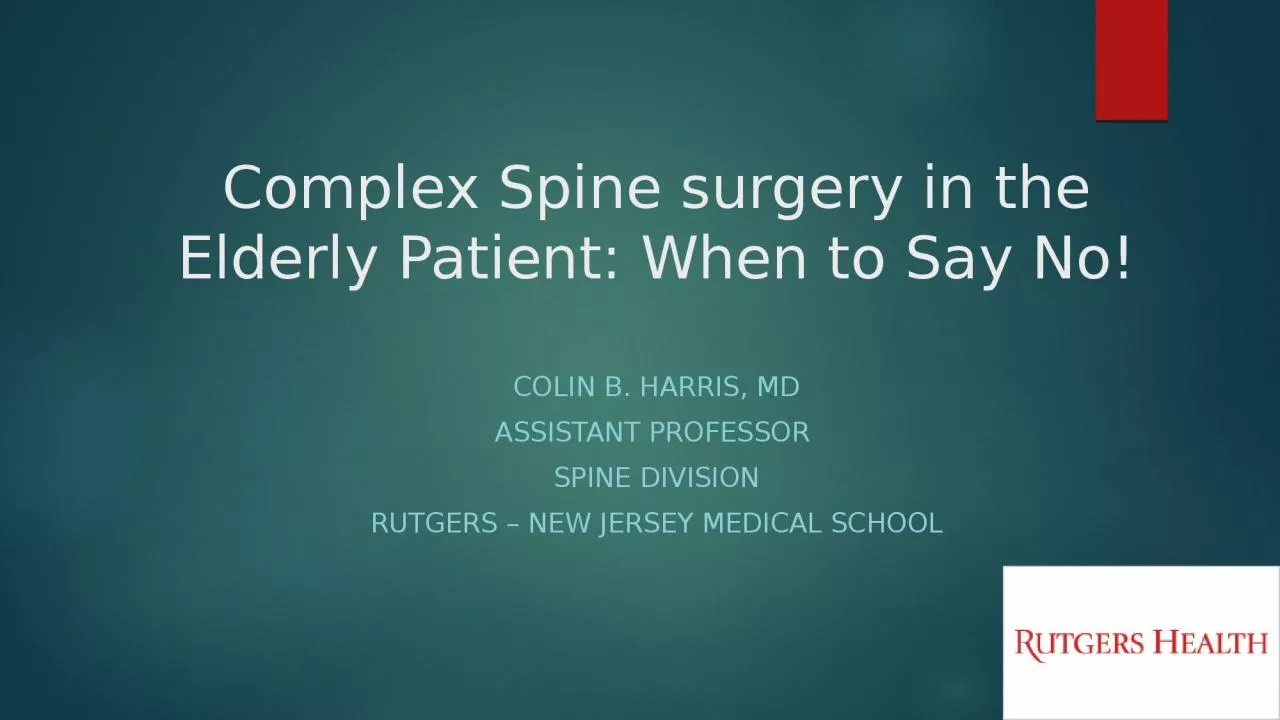

Colin b harris md Assistant professor Spine division Rutgers new jersey medical school DISCLOSURES CONSULTINGTEACHING GLOBUS INC Why are we talking about this today Adult spinal deformity ID: 1014281
Download Presentation The PPT/PDF document "Complex Spine surgery in the Elderly Pat..." is the property of its rightful owner. Permission is granted to download and print the materials on this web site for personal, non-commercial use only, and to display it on your personal computer provided you do not modify the materials and that you retain all copyright notices contained in the materials. By downloading content from our website, you accept the terms of this agreement.
1. Complex Spine surgery in the Elderly Patient: When to Say No!Colin b. harris, mdAssistant professor Spine divisionRutgers – new jersey medical school
2. DISCLOSURESCONSULTING/TEACHINGGLOBUS, INC
3. Why are we talking about this today?Adult spinal deformityHeterogeneousComplexOften requires surgery Surgery improves outcomes*HRQoL yearsHowever..Smith, Lafage, Shaffrey et al. Neurosurgery 2016.
4.
5. The factsAdult spinal deformity surgery OFTEN requires:Long dissectionsLong-segment spinal fusionOsteotomies6-8 hr + surgeryMultiple transfusion PRBCExtended hospitalizationCho, Bridwell, Lenke. Spine 2010Yagi, Rahm, Gaines. Spine 2014DeWald, Stanley. Spine 2006
6. What are the risks?Neurologic deficitImplant related complicationsSSIPneumonia/UTIDeliriumRenal failureIleusFailure to thrive
7. What are the risks?Neurologic deficitImplant related complicationsSSIPneumonia/UTIDeliriumRenal failureIleusFailure to thrive30-60%
8. What are the risks?Neurologic deficitImplant related complicationsSSIPneumonia/UTIDeliriumRenal failureIleusFailure to thrive30-60%New neurologic deficit 8.7%Mean EBL 2120 mLMean OR time 7 hours50.8% medical complicationsKelly M, Lenke L, Shaffrey C, et al. Neurosurg Focus 2014
9. Minimizing the risksPATIENT SELECTIONMedical optimizationMeticulous preoperative planning
10. Minimizing the risksMedical optimizationCardiologyPulmonologyEvery patient needs BMD evaluationNutrition status*Albumin >3.5 g/dLTotal lymphocyte count >1500 cells/mm3Transferrin >200mg/dLZinc >95 mg/dLGherini et al CORR 1993;293:188-95Greene et al J Arthroplasty 1991;4:321-5
11. ObesityDefined as BMI>30 (morbid obesity = BMI>40)Shown to result in increased risk of:Medical complicationsWound complicationsHigher cost per stayNutrition consult, involve PCPConsider bariatric referral BMI>30Puvanesarajah V, Werner B, Cancienne J, et al. Spine 42(2): 122-7, 2016
12. Database review of control, obese (BMI >30), morbidly obese (BMI>40)Obese/morbidly obese with higher rates of wound infection (3.5X), major medical complication (OR 1.79), respiratory failure, renal failureObese / MO with higher 30-day re-admission (OR 1.62) and LOSIn-hospital costs increased by $8,000Conclusion: Careful selection and counseling needed prior to surgery
13. Database review of 156,517 patients undergoing elective lumbar fusionNormal body weight (BMI <25) vs morbidly obese (BMI>40) vs bariatric surgery (BS) + obeseRates of UTI, respiratory failure, ARF, infection, medical complications lower in BS vs morbidly obese group (p<0.05)BS group = normal body weight group in medical complicationsBS higher infection, reoperation and readmission ratesConclusions: Consider referral for BS prior to elective spine fusion
14. OsteoporosisConsider teriparatide (Forteo) x9-12 months prior to surgeryMust coordinate with EndocrinologyBony union rate 82%* Decreased incidence pedicle screw loosening =/- Follow-up preop DEXA (controversial)Ohtori S, Inoue G, Orita S, et al. Spine 2012;37:E1464-8.*Ohtori S, Inoue G, Orita S, et al. Spine 2013;38:E487-92.
15. How about ASA class?ASA class III/IV = significant risk factor for:Mortality Reoperation within 30 daysLOSNeed for transfusion Postoperative sepsisMust counsel regarding increased complications & potential poor outcomeSomani S, Capua J, Kim J, et al. Global Spine J 7(8):719-26, 2017.
16. Preoperative planningConsider digital planning program (Surgimap, Nemaris, Inc)Must assess alignment on full length scoliosis radiographsCSVLC7 plumb lineSVA
17.
18. Goals of SurgeryDecompress neural elementsObtain solid fusionRestore spinal balanceAvoid complicationsSchwab F, Ungar B, Blondel B, et al. Spine 2012Glassman S, Bridwell K, Dimar J et al. Spine 2005
19. Goals of SurgeryPI – LL <11ºPT < 22ºSVA <5cmSagittal plane drives disabilityCoronal plane not so muchSchwab F, Ungar B, Blondel B, et al. Spine 2012
20. SVA +7cmPlanned correctionSVA 0
21. Preop PlanningSVA +12cmPI – LL = 44
22. Preop PlanningSVA +12cmPI – LL = 4412 cmC7 plumb
23. Executing the planConsider staging if >6hrs, EBL>1LStage 1: Exposure, remove prior implants, instrumentStage 2: Perform decompression, osteotomies, place graft / rodsLin J, Lenke L, Shillingford J, et al. Spine Deform 2018;6(2):189-94
24. Executing the planConsider staging if >6hrs, EBL>1LStage 1: Exposure, remove prior implants, instrumentStage 2: Perform decompression, osteotomies, place graft / rods2-surgeon approach can save time and EBLLin J, Lenke L, Shillingford J, et al. Spine Deform 2018;6(2):189-94
25. Executing the planConsider staging if >6hrs, EBL>1LStage 1: Exposure, remove prior implants, instrumentStage 2: Perform decompression, osteotomies, place graft / rods2-surgeon approach can save time and EBLConsider O-arm, Stealth, robotics for complex deformitiesCell Saver, 4-6 units T&C, neuromonitoringLin J, Lenke L, Shillingford J, et al. Spine Deform 2018;6(2):189-94
26. Executing the planConsider staging if >6hrs, EBL>1LStage 1: Exposure, remove prior implants, instrumentStage 2: Perform decompression, osteotomies, place graft / rods2-surgeon approach can save time and EBLConsider O-arm, Stealth, robotics for complex deformitiesCell Saver, 4-6 units T&C, neuromonitoringConsider tranexamic acid 50mg/k loading dose -> 5mg/kg/hr until closureLin J, Lenke L, Shillingford J, et al. Spine Deform 2018;6(2):189-94
27. Executing the planConsider BMP, ICBG for long fusionsMeticulous layered closure over drains, incisional wound VACPlastic Surgery paraspinal flaps helpful if wound under tensionObserve closely for new neuro deficits in first 24 hrs postop
28. ComplicationsEARLYParalysis, nerve root injury (most common)Infection, wound healing problemsBlood loss requiring transfusionCSF leakLATENon-union (leading to rod or screw fracture)Adjacent segment “PJK” (Proximal, Distal)>50%!
29. WHEN TO SAY NO!SmokersChronic opioid usePoorly controlled DM (HgbA1C >7)Osteoporosis – use caution T-score <2.5 SD below meanObesity (BMI > 40), Beware BMI > 35Chronic steroid useModerate or Severe COPDDe la Garza Ramos R, Nakhla J, Echt M, et al. Global Spine J 2018
30. Surgeon Experience Matters
31. Single surgeon early and late outcomes with posterior VCR N=34 consecutive patientsOverall 58% experienced complications (13 vs 3)Results:Group 1 (inexperienced): 492 min, EBL 1294, 22.8 day LOSGroup 2 (Experienced): 350 min, EBL 974, 13.4 day LOSCUSUM: complications may reduce after 17 cases and stabilize by 29 casesConclusion: PVCR is safer when performed by experienced surgeon
32. Bottom LineAdult deformity correction can improve QOL but fraught with dangersSuccess depends on many factors that must align:Meticulous planning & understanding of sagittal parametersMedical/nutrition/osteoporosis optimizationMust know when to say no…
33. If in doubt…Refer to a high volume tertiary centerGet a second opinion!
34. Thank you!